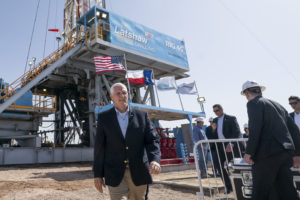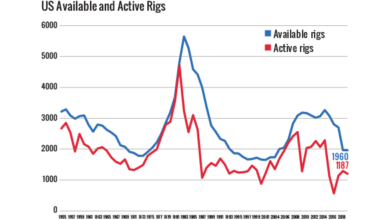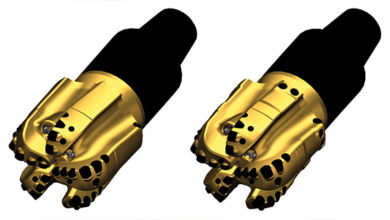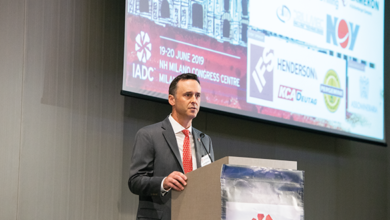Wirelines
Pence visits Latshaw Drilling Rig 45, recognizes contributions of drilling industry
On 17 April, US Vice President Mike Pence visited Latshaw Drilling Rig 45 in Midland, Texas, drilling for Diamondback Energy.

In his remarks, Vice President Pence noted, “It’s amazing to think what we can accomplish here in West Texas if we continue to unlock the incredible potential of the Permian Basin. Eighty-six thousand square miles hold 20 of the nation’s top 100 oil fields. And by 2023, I’m told they’ll produce 5.4 million barrels per day. That’s more than any area of the world other than two different countries. More than any single member of OPEC other than Saudi Arabia. That is energy dominance. That’s American leadership.”
The Vice President also recognized the work done by those working on the rig, attributing the success of the Permian Basin to those drilling in the region.
“We were honored to have VP Pence as a guest on our rig,” said Trent Latshaw, President, Latshaw Drilling. “His visit is a testimony to the support our industry is getting from this administration and how important our industry is to our economy, our military and our national security.”
Alongside Secretary of the Interior David Bernhardt and Railroad Commission of Texas Chairman Christi Craddick, Vice President Pence also said, “I really did want to come out here just to tell you how much the President and I support the work that you’re doing every day and how inspired we are and the American people are with the incredible progress that’s being made in the Permian Basin.”
NOPSEMA Releases Offshore Performance Report
On 27 May, Australian regulator NOPSEMA released its Annual Offshore Performance Report, summarizing the safety and environmental performance of Australia’s offshore oil and gas industry for 2018. The report indicated that the industry largely maintained its performance, particularly in protecting workers and the environment. Most importantly, for the sixth consecutive year, there were no fatalities.
Supreme Court rules on OCSLA jurisdiction
On 10 June, the US Supreme Court vacated the 9th Circuit Court of Appeals ruling in the Parker Drilling Management Services, Ltd. V. Newton case. The case hinged on whether California’s wage laws were applicable to time spent on “standby” on rigs on the outer continental shelf.
In 2018, the 9th Circuit Court of Appeals rules that offshore workers were entitled to minimum wage and overtime laws of the adjacent state.
However, in the unanimous ruling, Supreme Court Justice Clarence Thomas wrote, “All law on the OCS is federal, and state law serves a supporting role, to be adopted only where there is a gap in federal law’s coverage.” The ruling upholds the District Court’s original decision.
Under the Offshore Outer Continental Shelf Lands Act (OCSLA), structures attached to the continental shelf more than 3 nautical miles from the coast are under federal control and governed by federal law.
IADC disappointed in vote to block opening of ANWR
On 1 May, the US House Committee on Natural Resources voted on H.R. 1146, legislation that would block the US from moving forward with opening the Arctic National Wildlife Refuge for oil and gas development.
In response to the vote, IADC President Jason McFarland said that opening a portion of ANWR to oil and gas development and production has been a goal of IADC’s since the 1980s. “Therefore, IADC is disappointed by today’s vote in the House Natural Resources Committee that attempts to block future development of ANWR.
“According to the Congressional Budget Office, opening the area will create jobs and raise $1.1 billion in revenue over the next 10 years. In addition, opening ANWR keeps the US on the path of energy dominance, allowing the country to develop more of its own natural resources, which will be needed for decades to come. Based on their experience drilling thousands of wells in the US and internationally, IADC members have no doubt that oil and gas operations can be conducted in ANWR without harm to the area’s wildlife and in a manner that is compatible with the sensitive arctic environment. IADC and its members remain committed to supporting legislation that encourages environmentally sensitive and responsible drilling activities both in the US and internationally.”
US well positioned to meet low sulphur requirements
On 2 April, US Coast Guard Admiral John Nadeau addressed challenges pertaining to the 2020 low sulphur requirement during his keynote speech at the Connecticut Maritime Association’s Shipping Conference 2019. The US is positioned to have ample quantity and quality of fuel since emission control area requirements have been in place since 2015, requiring availability of 0.1% fuel. Availability challenges are expected outside of the US as many maritime operators have employed a “wait and see” approach to planning for the 2020 provisions.
USCG issues hurricane season reporting bulletin
The US Coast Guard recently issued the Gulf of Mexico OCS Marine Safety Information Bulletin (MSIB) 19-03; Hurricane Season Reporting Requirements.
The 8th Coast Guard district is requesting that operators of all manned facilities and MODUs report only when personnel who otherwise intended to evacuate the unit were stranded onboard and prevented from evacuating ahead of approaching heavy weather.
BSEE reports on risk-based inspection program
On 9 May, the US Bureau of Safety and Environmental Enforcement (BSEE) released a report highlighting the results of its risk-focused inspection initiative to supplement BSEE’s existing schedule of inspections and active drilling operations. These focused field inspections allow BSEE to verify that operators are properly identifying, managing and mitigating risks.
IADC Comments on Lebanese Petroleum Authority’s strategy document
The Lebanese Petroleum Authority (LPA) recently issued a draft Environmental Strategy Assessment that will likely contribute to a regulatory framework for the country’s burgeoning offshore oil and gas operations. IADC provided comments to the LPA to clarify observations contained in the assessment.
In addition, IADC President Jason McFarland said, “As the LPA continues to develop the necessary framework to build the country’s offshore industry, a balanced and pragmatic approach to implementing best practice methodologies will be critical. Optimizing productivity while sustaining a robust safety regime that ensures the well-being of the environment and those working offshore should be the priorities for the LPA. IADC and its members look forward to continuing to serve as an educative resource to the LPA as drilling operations in the country begin.”




